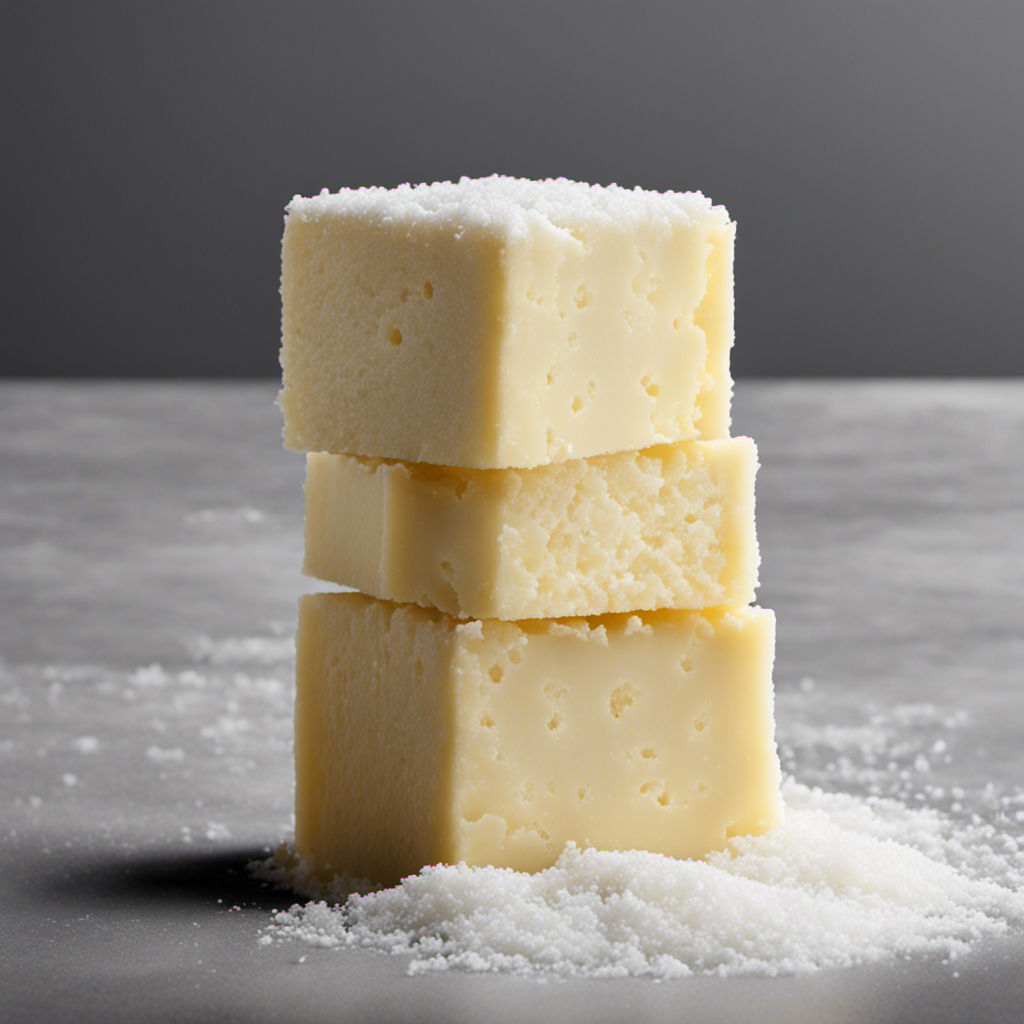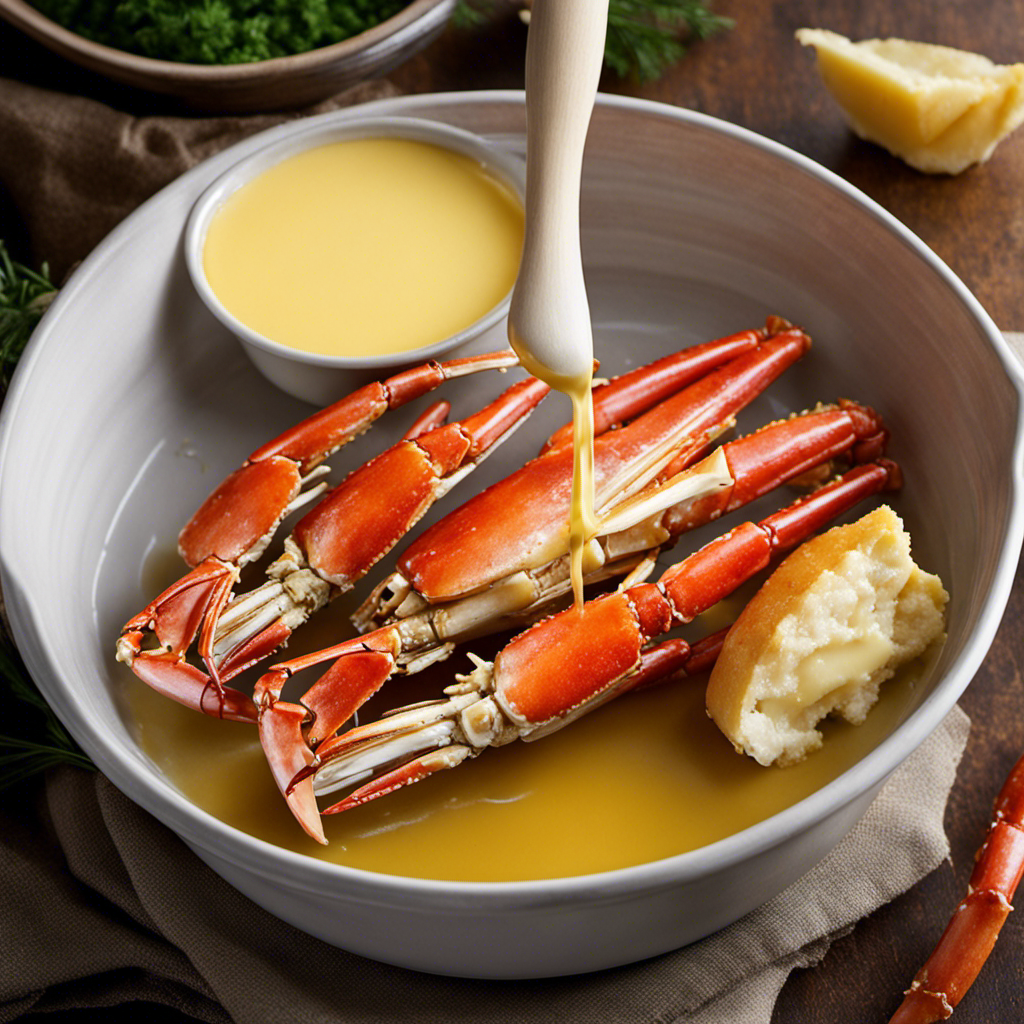Just like how a pinch of salt can enhance a dish, the perfect amount of salt can take homemade butter to the next level. In this article, I will explore the science behind salted butter and help you determine the perfect ratio of salt to butter.
We will explore different methods for incorporating salt, share tips for achieving the perfect level of saltiness, and discuss how to adjust salt levels to suit your personal taste preferences.
Say goodbye to bland butter and get ready to embark on a flavorful journey.
Key Takeaways
- Salt is crucial in making salted butter as it dissolves into the water content of butter and disrupts the structure of fat molecules, changing the texture and flavor.
- Salt acts as a natural preservative for butter, extending its shelf life by inhibiting bacteria growth.
- Salt enhances the flavor of butter, adding a savory note, and improves its texture, making it smoother and more spreadable.
- Salt’s preserving effect is due to its ability to draw out moisture from food and create a high-salt environment that inhibits spoilage-causing bacteria.
The Science Behind Salted Butter
To understand the science behind salted butter, you need to know how salt interacts with the fat molecules in the butter. When salt is added to butter, it dissolves into the water content of the butter. This dissolved salt then interacts with the fat molecules by disrupting their structure.
The salt’s impact on the fat molecules leads to a change in the texture and flavor of the butter. Salt’s chemical reaction with the fat molecules also helps to enhance the overall taste profile of the butter, balancing out the richness with a subtle savory note.
Understanding salt’s impact and its chemical reaction with the fat molecules is crucial in the process of making salted butter. It sets the foundation for understanding the role of salt in butter making and how it contributes to the final product’s characteristics.
Understanding the Role of Salt in Butter Making
Salt plays a crucial role in butter making, offering several key benefits.
Firstly, salt acts as a natural preservative, extending the shelf life of butter by inhibiting the growth of bacteria.
Additionally, salt enhances both the flavor and texture of butter, adding a savory note and creating a smoother, more spreadable consistency.
Lastly, by controlling bacteria growth, salt ensures the safety and quality of the butter, making it an essential ingredient in the butter-making process.
Salt’s Preserving Effect
You can easily understand salt’s preserving effect when you observe how it extends the shelf life of various food products. Salt has been used for centuries as a natural preservative due to its ability to draw out moisture from food, thereby preventing the growth of bacteria and other microorganisms.
By creating a high-salt environment, salt inhibits the growth of spoilage-causing bacteria and fungi, helping to keep food fresh for longer periods.
Beyond its preserving properties, salt also plays a crucial role in enhancing the flavor of food. However, it is important to note that excessive salt consumption can have negative health effects, such as increased risk of high blood pressure and heart disease.
Therefore, it is essential to strike a balance and moderate our salt intake to maintain a healthy lifestyle.
Enhancing Flavor and Texture
Adding a pinch of salt to your favorite dish can greatly enhance its flavor and texture. Salt is a versatile ingredient that not only adds taste but also improves the overall quality of a dish.
When used in the right amount, salt can enhance the natural flavors of ingredients, making them more pronounced and enjoyable. It acts as a flavor enhancer by stimulating our taste buds and making the dish more satisfying.
Additionally, salt can also improve the texture of certain foods. It helps to tenderize meat, giving it a more succulent and juicy texture. It can also enhance the texture of baked goods, making them light and fluffy.
Controlling Bacteria Growth
To control bacteria growth in your dishes, it’s important to be mindful of proper food handling and storage techniques.
Bacteria can multiply rapidly in food, leading to foodborne illnesses.
One effective bacteria control technique is to use salt. Salt has been used for centuries as a natural preservative due to its ability to draw out moisture from food, which inhibits bacterial growth. It works by creating an environment that is inhospitable for bacteria to thrive.
Additionally, salt can extend the shelf life of certain foods. By reducing the water content, salt helps to prevent spoilage and maintain the quality of the food for a longer period.
Therefore, incorporating salt into your food preparation and storage practices can help ensure the safety and freshness of your dishes.
Calculating the Ideal Salt to Butter Ratio
Once you’ve determined the ideal ratio, it’s important to properly measure and mix the salt and butter together.
Salt measurement techniques are crucial in achieving the perfect level of saltiness in your salted butter. To ensure accuracy, use a kitchen scale to measure the desired amount of salt. The most common ratio is 1 teaspoon of salt per 1 cup of butter, but you can adjust it according to your preference.
Start by melting the butter and then gradually add the salt while stirring continuously. This will ensure that the salt is evenly distributed throughout the butter. Mixing the salt and butter thoroughly is key to achieving a well-balanced flavor.
Now that you’ve mastered the art of measuring and mixing, let’s move on to the factors to consider when adding salt to butter.
Factors to Consider When Adding Salt to Butter
When determining the ideal ratio, it’s important to consider factors such as personal preference and the dish you are preparing.
Salt measurement techniques can vary depending on the desired outcome. One common method is to use a measuring spoon to add a specific amount of salt to the butter. This ensures precise measurements and allows for easy adjustments if needed.
Another technique is to sprinkle salt directly onto the butter and taste as you go. This allows for a more subjective approach, where you can adjust the salt levels according to your personal preference.
It’s essential to remember that salt enhances flavors, so start with a small amount and gradually add more if necessary. Experimentation and tasting are key in finding the perfect balance of salt in your butter.
Different Methods for Incorporating Salt Into Butter
There are various techniques you can use to infuse butter with the flavor of salt.
One method is to use different salt types, such as sea salt or kosher salt, to add a unique taste to your butter. You can simply sprinkle the desired amount of salt onto softened butter and mix it thoroughly.
Another option is to make a salt brine by dissolving salt in water and then incorporating it into the butter. This allows for a more even distribution of salt throughout the butter.
If you prefer to avoid salt altogether, there are also salted butter alternatives available in the market that already have the perfect balance of salt. These alternatives provide a convenient option for those who want the taste of salted butter without the hassle of adding it themselves.
Tips for Achieving the Perfect Level of Saltiness in Salted Butter
When it comes to achieving the perfect level of saltiness in salted butter, two key points to consider are salt measurement techniques and balancing salt with sweetness.
Salt measurement techniques play a crucial role in ensuring the desired saltiness of the butter, whether it is through precise measurements or using taste as a guide.
Balancing salt and sweetness is another important aspect, as it helps create a harmonious flavor profile by complementing the saltiness with a hint of sweetness.
Salt Measurement Techniques
To accurately measure salt for making salted butter, you’ll need to use specific techniques. First, it’s important to remember that salted butter should have a perfect balance of saltiness, neither too bland nor too salty. Here are some tips for achieving the perfect level of saltiness:
- Use a precise measuring spoon: A teaspoon or tablespoon will be accurate enough for most recipes.
- Taste as you go: Start with a small amount of salt and gradually add more, tasting the butter along the way. This will help you achieve the desired level of saltiness.
- Consider the recipe: Different recipes may require different amounts of salt. Pay attention to the instructions and adjust accordingly.
Balancing Salt and Sweetness
Achieving the perfect balance of saltiness and sweetness in my dishes can elevate their flavor to a new level. Balancing flavors is a delicate art that requires careful consideration of the flavor profiles involved.
When it comes to salt, adding just the right amount can enhance the taste of a dish without overpowering it. Too little salt can leave a dish bland, while too much can make it unpleasantly salty.
The key is to find the sweet spot where the saltiness enhances the other flavors in the dish. This can be achieved through experimentation and tasting as you go.
Adjusting Salt Levels to Suit Personal Taste Preferences
If you want your salted butter to suit your personal taste preferences, you can adjust the salt levels accordingly. Experimenting with different salt types can also help you achieve the desired saltiness levels.
Here are some ways to adjust the saltiness of your butter:
- Start with a small amount of salt and gradually increase it until you reach your desired taste.
- Taste the butter after each addition of salt to ensure you don’t overdo it.
- Consider using different types of salt, such as sea salt or Himalayan salt, to add different flavors to your butter.
Common Mistakes to Avoid When Salting Butter
When adjusting the seasoning of your butter, be careful not to add too much salt, as it can overpower the other flavors. One of the common mistakes people make when salting butter is going overboard with the salt. It’s important to achieve the right level of saltiness without overwhelming the taste buds.
To help you avoid this common mistake, here are some tips:
- Start with a small amount of salt and gradually add more if needed.
- Taste the butter as you go along to ensure you’re achieving the desired level of saltiness.
- Remember that the saltiness will intensify over time, so be mindful of this when salting your butter.
Frequently Asked Questions
Can I Use Any Type of Salt to Make Salted Butter?
I can use different types of salt to make salted butter. The amount of salt needed depends on personal preference. It’s important to add enough to enhance the flavor, but not too much to overpower it.
Does Salt Affect the Texture of Butter?
Salt affects the texture of butter by adding a slight graininess. It enhances the taste and helps preserve the butter, giving it a longer shelf life.
How Long Does It Take for the Salt to Fully Incorporate Into the Butter?
It typically takes a few minutes for the salt to fully incorporate into the butter. This time may vary depending on the temperature of the butter. Adding salt enhances the flavor of the butter.
Can I Add More Salt to the Butter After It Has Been Made?
Yes, you can add more salt to the butter after it’s made. I once added salt to unsalted butter to enhance the flavor. This can also be done with other dairy products like cream cheese.
How Should Salted Butter Be Stored to Maintain Its Freshness?
To maintain freshness and prevent salted butter from going bad, store it in an airtight container in the refrigerator. Keep it away from strong-smelling foods to prevent absorption of odors.
Conclusion
In conclusion, understanding the science behind salted butter is essential for achieving the perfect level of saltiness. By calculating the ideal salt to butter ratio and considering factors such as personal taste preferences, one can create a truly delicious and well-balanced butter.
Different methods for incorporating salt into butter can also be explored to find the best technique. However, it is important to avoid common mistakes when salting butter.
So, if you’re ready to take your butter-making skills to the next level, stay tuned for more tips and tricks.










